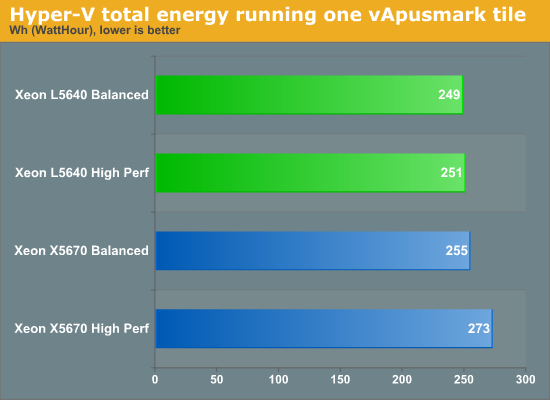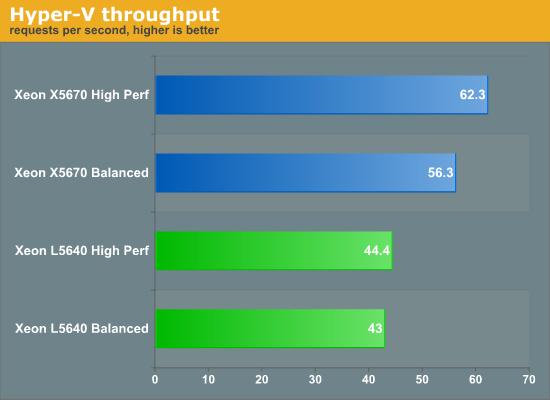Low Power Server CPUs: the energy saving choice?
by Johan De Gelas on July 15, 2010 4:54 AM EST- Posted in
- IT Computing
Energy measurements
So we measured the power over a period of 70 minutes (longer than the slowest test run), and calculated the real energy (power x time) consumed.


You can see that with the exception of the Xeon X5670 running with the high performance plan, there is almost no difference between the L5640 measurements and the “balanced” X5670. And let us look at performance now. We made a geometric mean of the number of URL/s and the number of database transactions that the server was able to process.

This graph explains why the Xeon X5670 does so well: as it is able to handle more transactions and web requests per second, it can empty the queues more quickly. When the web request and database queues are empty, the CPU can throttle back and save power. Since the idle power of the Xeon X5670 is pretty low (almost as good as the idle power of the low power version), this is a real tangible advantage.
Response time
At the end of day, users will not complain about throughput, they experience high response times as disturbing. Responses times are the ones that are part of the SLAs. Let us see what we measured. We made a geometric mean of the response time of the database queries and web requests.

The results are stunning! Despite the fact that we do not max out the CPUs at all, the X5670 leaves the low power version far behind when it comes to response times. This is partly due to the fact that vApus Mark I is constructed as a CPU test. In your own datacenter you might not see the same results if you are (partly) I/O constrained of course. But if web and database applications are well cached, the higher performing CPU can deliver tangible lower response times.










49 Comments
View All Comments
cserwin - Thursday, July 15, 2010 - link
Some props for Johan, too, maybe... nice article.JohanAnandtech - Thursday, July 15, 2010 - link
Thanks! We have more data on "low power choices", but we decided to cut them up in several article to keep it readable.DavC - Thursday, July 15, 2010 - link
not sure whats going on with your electricity cost calcs on your first page. firstly your converting current unnessacarily from watts to amps (meaning your unnessacarily splitting into US and europe figures).basically here in the UK, 1kW which is what your your 4 PCs in your example consume, costs roughly 10p per hour. working on an average of 720 hours in a month, that would give a grand total of £72 a month to run those 4 PCs 24/7.
£72 to you US guys is around $110. And I cant imagine you're electricity is priced any dearer than ours.
giving a 4 year life cycle cost of $5280.
have I missed something obvious here or are you just out with the maths?
JohanAnandtech - Thursday, July 15, 2010 - link
You are calculating from the POV of a datacenter. I take the POV of a datacenter client, which has to pay per amp that he/she "reserves". AFAIK, datacenters almost always count with amps, not Watts.(also 10p per KWh seems low)
MrSpadge - Thursday, July 15, 2010 - link
With P=V*I at constant voltage power and amps are really just a different name for the same thing, i.e. equivalent. Personally I prefer W, because this is what matters in the end: it's what I pay for and what heats my room. Amps by themselves don't mean much (as long as you're not melting the wires), as voltages can easily be converted.Maybe the datacenter guys just like to juggle around smaller numbers? Maybe the should switch over to hecto watts instead? ;)
MrS
JohanAnandtech - Thursday, July 15, 2010 - link
I am surprised the electrical engineers have not jumped in yet :-). As you indicate yourself, the circuits/wires are made for a certain amount of amps, not watts. That is probably the reason datacenters specify the amount of power you get in watt.JohanAnandtech - Thursday, July 15, 2010 - link
I meant amps in that last sentence of course.knedle - Thursday, July 15, 2010 - link
Watts are universal, doesn't matter if you're in UK, or US - 220W is still 220W, but with ampers it's different. Since in the Europe voltage is higher than in the USA (EU=220V, US=110V), and P=U*I, you've got twice as much power for 1A, which means that in USA your server will use 2A, while the same server in UK will use only 1A...has407 - Friday, July 16, 2010 - link
No, not all Watts are the same.Watts in a decent datacenter come with power distribution, cooling, UPS, etc. Those typically add 3-4x to the power your server actually consumes. Add to that the amortized cost of the infrastructure and you're looking at 6-10x the cost of the power your server consumes directly.
Such is the fallacy of simplistic power/cost comparisons (and Johan, you should know better). Can we now dispense with the idiotic cost/KWH calculations?
Penti - Saturday, July 17, 2010 - link
A high-performance server probably can't be used on 1A 230V which is the cheapest options in some datacenters. However something like half a rack or 1/4 would probably have 10A/230V, more then enough for a small servercollection of 4 moderate servers. The big cost is cooling, normal racks might handle 4kW (up to 6kW over that then it's high density) of heat/power just. Then you need more expensive stuff. A cheap rack won't handle 40 250W servers in other regards. 6 kW power/cooling and 2x16A/230V shouldn't be that expensive. Any way you also pay for cooling (and UPS). Even cheap solutions normally charge per used kW here though. 4 2U is about 1/4 rack anyway. And like 15 amps is needed if in the states.